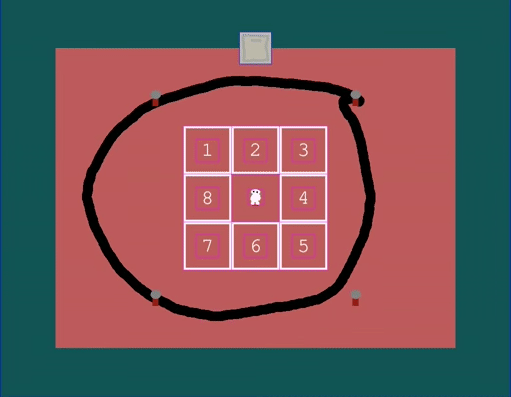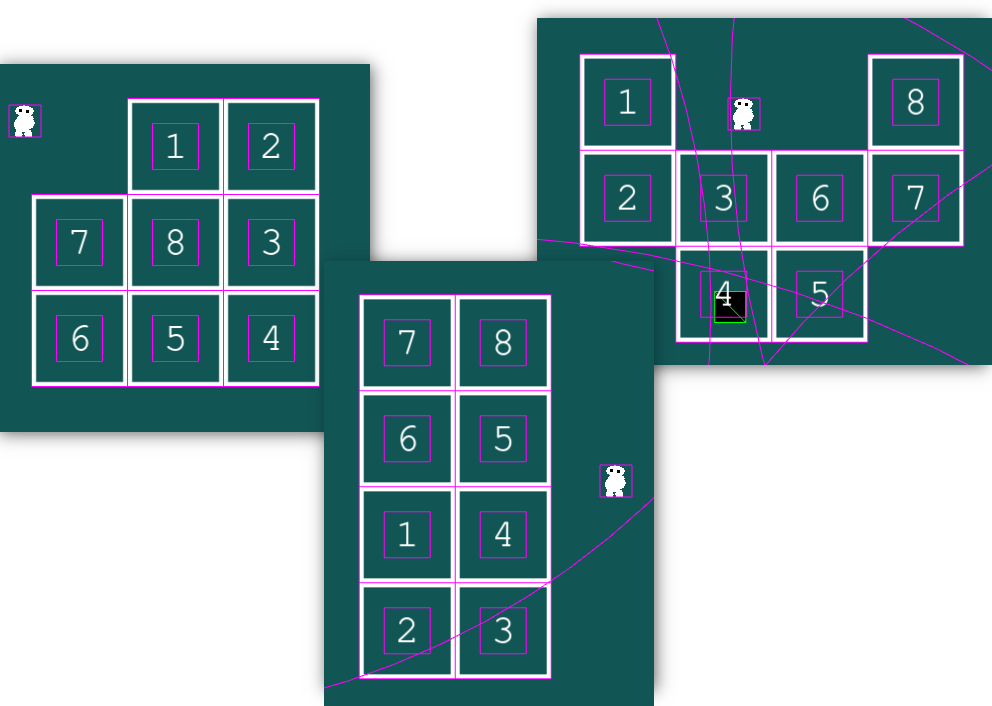Whispering Tracks Devlog #4 - Working on navigation
Now that the music aspect of Whispering Track is complete, I can work again on its game-design. Most of the mechanics were already implemented, but there's still some tweaking to do. This time, it was mostly about making the exploration of the world smoother. Which makes sense, since Whispering Tracks is an exploration game after all!
Edges of the world
The map of the game is a finite one, as there is no procedural generation. However, I still want the player to be able to walk endlessly in one direction! For that, we'll use the oldest trick there is: a circular map! Walking past the north border will warp you to the south one, and same for west and east. The goal is also to disorientate the player: while going left, they will come across a zone they thought was on the right, and eventually they will even find themselves back at the start screen without understanding how they got here! I just love the feeling of getting lost, and this game is kinda about it.
Warping the player through code was easy. It's just about teleporting them from (X, MAX_Y) to (X, MIN_Y). The dynamic music was able to follow through, since it works with collision area that detects if the player enters or leaves! However, there is a detail that breaks the illusion. If you look at the map, you can see on the edges between areas that instruments are overflowing. This is voluntary: it makes them blend when you walk from one area to the other, giving you the sensation of getting closer to a new place, or leaving the previous one. However, when you are teleported from one side of the map to the other, the change is immediate! This doesn't sound natural.
The solution therefore was to duplicates the detection areas of instruments. If it is close to the east border, it should have an identical area beyond the west border. So that when the player is teleported, they are still in the "view range" of the instrument, and thus can still hear it. It needed a little bit of logic to use a group of collision areas instead of a single one, but it eventually worked smoothly! On top of that, I added a new properties to the instruments: a stereo pan! They will play more on the left speaker if they are on the left of the player, and reciprocally. This helps a bit the player to orientate themself, and strengthen the sensation of moving inside an orchestra. With that in place, warping really feels like walking from a zone to the other. The illusion of a circular world is perfect!

Better tiles
One thing I mentioned in the last entry is that the tiles sound still needed to be implemented. Well, that's been done! I was able to nail down synth sounds that blend nicely with the music, are noticeable enough, and pleasant to hear. I also added a glockenspiel chord played once the puzzle is solved, which makes it even more satisfying!
However, it's not the only improvement done to the tiles. The ones I implemented during the jam were kinda messy. More than often you would hear two play at the same time because you entered them just on the edge. And sometimes they wouldn't activate properly because you moved to fast between one and the other! Not only this was unpleasant, but it could also be a source of confusion for the player. Especially given that the tiles will be invisible! They can only be detected with sound, thus this one must be very precise!
I came to a simple solution, which could actually be handy for later games. Instead of having one collision area for the tile (which works like a press button), I now have two: one outside, and one inside. The button is "pressed" when the player enters the inside one. It is "unpressed" when the player leaves the outside. This gives the impression that the button requires the player to apply their full weight to the center! But more importantly, the margin between the buttons prevents the player to be on two buttons at the same time! They can now enter them diagonally, or, stay on the edges, it will always react smoothly.

By the way, this is the start screen of the game. Well, still with no visual assets, of course. I changed the first puzzle of the game to be more accessible to visually impaired players. That's right, since the game relies mostly on sound, that's a goal that I set. The previous version required the player to enter the path from one entrance, and navigate through walls. This would be the only time there would be walls in the game, which is already a bad sign! My goal was to make the player understand that the tiles make a sound when they are inactive, and a different one when they are activated. However, not only it had a weird shape, it would be very easy to miss for someone who cannot see! How is the player supposed to know they have to go down if they do not have the visuals? What happens if they endlessly bump on walls from the outside? Now, there are no walls, and no matter which direction the player goes first, they are certain to walk on a tile and hear it! There is a small chance that they hit the number 1 tile first and never hear the inactive tile sound, but since it must be reached diagonally, the probabilities are low. Hopefully if that happens, they'll still notice them in the game.
Notice also that there are now 8 tiles in a path, and not 7 anymore. That's because I also changed the notes they made. Previously, they would play kind of an augmented chord. That was musically interesting, but way less easier for players who don't have a musical ear. Now, it just plays on the scale: D, E, F, G, A, B, C, D! It's thus easier to look for adjacent notes when walking on a path, and remembering the melody it's supposed to play. I thus have placed the four different puzzles across the level, in places that are far enough of the center, and surrounded by some of the best sections of the music. I also varied their pattern to make them challenging! As stated, they will be invisible, so the player will need to listen to them when walking and deduce from the note they play in which order they must activate them. I searched for interesting and tricky paths to implements. There might be the need of crayons and paper to solve them!

I found one issue though. Even if the tiles are large, those paths are easy to miss! The map is very large, and the tiles being completely invisible, it is very likely that the player will walk next to them without realizing there is something to do. I can't rely on pure luck to expect the player to search randomly and walk in circles in frustration for hours until they step by accident on one of the tile! What a terrible experience it would be to explore the same place multiple time, and having to search in each square for a trigger. In a regular exploration game, player would be able to see their objective from a distance. But here… They need to hear them! How should I do that in a way that does not conflict with the music? Well, I have a little idea for that. And that's what I intend to work on. See you next time to see how it went!
Echoes Traveler
Explore a musical world
| Status | Released |
| Author | Itooh |
| Genre | Puzzle |
| Tags | Exploration, Music, Pixel Art, Walking simulator |
More posts
- Echoes Traveler can now be played on mobile21 days ago
- Echoes Traveler is 2 years old today!Nov 26, 2023
- v1.1 : Tutorial & UI improvementsJan 01, 2022
- Echoes Traveler 1.0 Release!Nov 26, 2021
- Echoes Traveler Devlog #8 - Ending cutsceneNov 22, 2021
- Echoes Traveler Devlog #7 - Presentation and communicationOct 17, 2021
- Echoes Traveler Devlog #6 - Finally it looks like something!Oct 04, 2021
- Whispering Tracks Devlog #5 - LED InstallationSep 19, 2021
- Whispering Tracks Devlog #3 - The sounds of the worldAug 23, 2021
Leave a comment
Log in with itch.io to leave a comment.